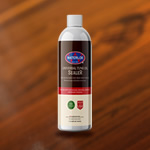Water and Waterlox® ORIGINAL Tung oil products.
The origin of our name, Waterlox®, stands for “locks out water.” Therefore, we think our Waterlox® tung oil finishes are the perfect solution for any and all wood finishing project(s). When you add to that your plans to finish a known water-related area like a bathroom, kitchen, counter top or table top, we think Waterlox® … Water and Waterlox® ORIGINAL Tung oil products.








